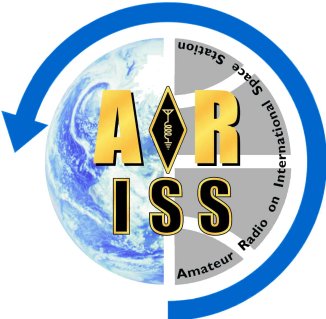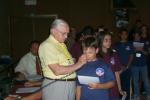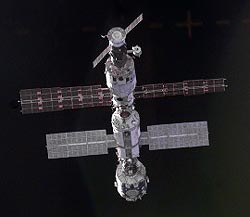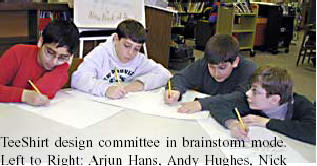Search for something
| ARISS Project at the Salt Brook School Club
Final Meeting of the Salt Brook Statics Ham Radio ClubJune 19, 2006 -- Students at the Salt Brook Elementary School, in New Providence, held their last Ham Radio Club meeting in the school library on Monday June 19th. During the year the students have been learning about radio communication, electronics, geography, space science and other technical subjects. These are the kids who held a successful Ham Radio conversation with American astronaut Jeff Williams on Monday, June 5th, 2006. Williams is currently orbiting the earth on the International Space Station. NPARC the amateur radio club for the Watchung Hills area has been coordinating the after school Ham Radio Club at Salt Brook for over three years. This volunteer activity helps the students learn and understand many aspects of science, geography and other studies. The Ham Radio Station, which was set up at the school for this purpose, is licensed to NPARC and was under the control of federally licensed NPARC Members. One of the NPARC members is Nick Esposito KC2ONP of New Providence, who is a seventh grade student at the New Providence Middle School. The radio club and the station was able to provide an exciting learning experience for the students due to the cooperation and assistance of the New Providence School District, including the Principal of Salt Brook, Ms. Jean Maier, the lead teacher for the club, Ms. Cathy Cleenput, and many members of the school staff and administration. The Ham Radio activities of NPARC, aimed at providing these educational and enjoyable experiences will continue during the summer, through the summer camp programs of the New Providence and the Berkeley Heights Recreation Commissions.
June 5, 2006: ARISS Contact a success! The Salt Brook School "Statics" made contact with astronaut Jeff Williams KD5TVQ aboard the International Space Station at approximately 9:55 a.m. on Monday June 5th. A team of students led by net control operator Nick KC2ONP, was able to ask 12 questions of Jeff as the ISS whizzed by on a 10 minute northwest-to-southeast pass. The contact was witnessed in the school auditorium by most of the school's students and teachers, and many interested parents, who cheered wildly when the contact was established. Their exhilaration came on the heels of a major disappointment on the previous Tuesday when a mix-up in frequencies produced a "no go" on the original date for the contact. The ARISS contact culminated over 2 years of preparation by the students, teachers, and their NPARC mentors, including Barry K2JV, Frank N2EZR, Vince KC2IZK, Harry AB2CM (SK), Bob KB2IKC, Nick Esposito KC2ONP, Lauryn WW2OLF, and Emily KC2KMK. Click on any image below to see a larger picture
"Independent Press" Newspaper Report of the contact
History of Club Reports For the last few years, the NPARC club has been holding its meetings in the cafeteria of the Salt Brook Elementary School in New Providence NJ. As a way of thanking the school for this courtesy and to further our objective of introducing amateur radio to new people, the club -- spearheaded by Barry K2JV -- offered the school guidance in getting enrolled in the ARISS (Amateur Radio International Space Station) "Talk to the Astronaut" program. The ultimate reward of the program is a 10 minute radio contact with an astronaut flying aboard the International Space Station (ISS). The school accepted our offer and worked with us on the official application. Our application has now been approved, although it may be 2006-7 before the school's name perks to the top of the list and the kids finally get to talk to the astronaut. In the meantime, the school will begin grade-appropriate educational programs that relate to space travel and radio. To maximize the educational experience, the students will be encouraged to do as much as they can on their own to prepare for and conduct the actual ISS radio contact. This includes developing the questions they will ask the astronauts, actually asking the questions on the air, and using computers to track the path of the ISS as it flies overhead. NPARC club members will act as advisors during this process and will provide the radios, special antennas, and other equipment needed to maximize the duration and quality of the eventual ISS radio contact. In addition, in November 2003, NPARC helped the school start an extra-curricular radio club (see the December Spark Gaps). The school club meets twice a month and NPARC club members work with students in learning radio theory, operating practices, and the Morse code -- and in assisting them in making actual radio contacts. We are especially proud of the leadership and commitment shown by our high school club members Lauryn WW2OLF and Emily KC2KMK who volunteered to work with the school club and the school's ARISS project before they went off to college in 2005
We will use this page to record progress on both the school club and the status of the ARISS (Amateur Radio International Space Station) project. If you would like further information about these projects and/or would like to get involved, please contact Barry K2JV. ARISS Links:Note: Currently the ISS listens on 144.49 and transmits on 145.80
December 2005 Update The Yagi antennas are UP!! Take a look at the roof of the Salt Brook School, from the basketball courts, and youll see the Yagi array which will be used for the ARISS astronaut contact. The antennas are currently operated from the library, which is the usual Statics meeting place. Sometime in March or early April, however, we will move the feed and control lines to the schools auditorium from which the actual conversation (QSO) will take place. We expect the QSO to be in April 2006, but no firm date is scheduled yet. From now on, every meeting of the Statics will include practice runs of speaking with an astronaut. If the kids have enough practice speaking with a club member who simulates being in space, theyll be able to handle a conversation with a real astronaut who is orbiting the earth on the International Space Station. The usual activities for the kids, including Morse code practice, HF operating, VHF operating with the Hand Held radios, etc. will also continue at each meeting if we get enough Club Members present to act as control operators. Fortunately we have a few regulars who usually come to the kids meetings. These include Frank K2EZR, Vince KC2IZK, and Nick KC2ONP. We could certainly use a few more licensed hams at the meetings. The new batch of tee shirts will be ordered soon, so any NPARC members who want one should contact K2JV ASAP. March 2004 SBS ARC News! The Salt Brook School kids have selected a name for their radio club! They worked on it, they did it themselves, and they came up with the name: Salt Brook Statics . This group of extraordinary bright and interested kids also came up with a Club Motto: Get Connected Now they are hard at work designing the art work for the Clubs Tee Shirt, which hopefully will be completed and manufactured before the school year is finished. Of course they do all this in addition to learning Ham Radio Communications, Morse Code, how to track a satellite with a directional antenna, and actually getting on the air. NPARC club members are encourage to come work with the students at a Statics meeting at 3PM on the second and fourth Monday of every month.
Record of the First SBS ARC Meeting: The first meeting of the Salt Brook School Amateur Radio Club occurred on Monday 24 November 2003. There were a total of 52 kids who "signed up" for the program before they shut off registrations, and 36 actually showed up for the first meeting. The teacher in charge of the Club is Ms. Cathy Cleenput, who is the "Gifted and Talented" special teacher for the New Providence school district. The photos above were taken by Ms. Cleenput. Five "activity centers" were available for the kids to visit as they so chose: Morse Code: Harry AB3CM had 2 code oscillators and keys, and started seven kids on their way to learning the "secret code." Satellite tracking: Bob K2GLS had his laptop running the tracking program, and started them on an understanding of orbits, rising & setting, altitudes and azimuths, etc. Things they will need to know when the ARISS program really gets going. Communications with Phonetic alphabets: Emily KC2KMK and Eric N2VI with a pair of HT's (hand-held radios) on a two meter frequency started a big batch of kids on their way to understanding point-to-point Radio -- that's Romeo Alfa Delta India Oscar. On the air QSO's (conversations): Barry K2JV had a 2 meter FM transceiver on the club frequency 145.75, and the kids were able to speak with and ask questions of our "Resident Astronaut", Bob KB2IKC, in his space station at home. Publicity Committee: Lauren WW2OLF's and Stephanie's center drew the largest group of kids. That group came up with some fantastic and original designs for: SUMMARY --- This was a great start for a Ham Radio Club and the ARISS radio contact project. We'll continue doing the same kind of things -- and more -- at future meetings, encouraging the kids to move from center to center as time goes by. K2JV reporting. Out. ARISS Links:Note: For casual voice contacts, the ISS listens on 144.49 and transmits on 145.80. For packet contacts, listen on 145.99 and transmit on 145.80 (North America passes). You may need to shift your receive frequency slightly (5 kHz) for Doppler effects -- tune slightly higher at the start of the pass and slightly lower at the end of it.
|









